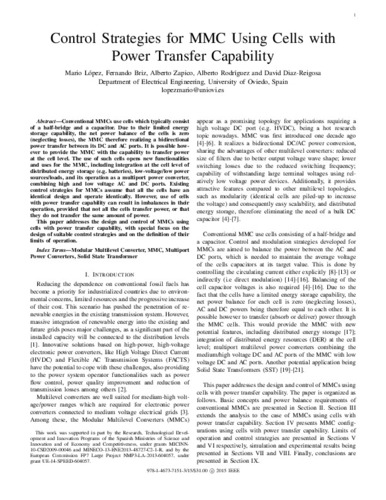Control strategies for MMC using cells with power transfer capability
Publication date:
Editorial:
IEEE
Publisher version:
Descripción física:
Abstract:
Conventional MMCs use cells which typically consist of a half-bridge and a capacitor. Due to their limited energy storage capability, the net power balance of the cells is zero (neglecting losses), the MMC therefore realizing a bidirectional power transfer between its DC and AC ports. It is possible however to provide the MMC with the capability to transfer power at the cell level. The use of such cells opens new functionalities and uses for the MMC, including integration at the cell level of distributed energy storage (e.g. batteries), low-voltage/low power sources/loads, and its operation as a multiport power converter, combining high and low voltage AC and DC ports. Existing control strategies for MMCs assume that all the cells have an identical design and operate identically. However, use of cells with power transfer capability can result in imbalances in their operation, provided that not all the cells transfer power, or that they do not transfer the same amount of power. This paper addresses the design and control of MMCs using cells with power transfer capability, with special focus on the design of suitable control strategies and on the definition of their limits of operation
Conventional MMCs use cells which typically consist of a half-bridge and a capacitor. Due to their limited energy storage capability, the net power balance of the cells is zero (neglecting losses), the MMC therefore realizing a bidirectional power transfer between its DC and AC ports. It is possible however to provide the MMC with the capability to transfer power at the cell level. The use of such cells opens new functionalities and uses for the MMC, including integration at the cell level of distributed energy storage (e.g. batteries), low-voltage/low power sources/loads, and its operation as a multiport power converter, combining high and low voltage AC and DC ports. Existing control strategies for MMCs assume that all the cells have an identical design and operate identically. However, use of cells with power transfer capability can result in imbalances in their operation, provided that not all the cells transfer power, or that they do not transfer the same amount of power. This paper addresses the design and control of MMCs using cells with power transfer capability, with special focus on the design of suitable control strategies and on the definition of their limits of operation
Description:
IEEE Energy Conversion Congress and Exposition, ECCE 2015 (2015. Montréal)
ISBN:
Patrocinado por:
This work was supported in part by the Research, Technological Development and Innovation Programs of the Spanish Ministries of Science and Innovation and of Economy and Competitiveness, under grants MICINN- 10-CSD2009-00046 and MINECO-13-ENE2013-48727-C2-1-R, and by the European Commission FP7 Large Project NMP3-LA-2013-604057, under grant UE-14-SPEED-604057
Collections
Files in this item





